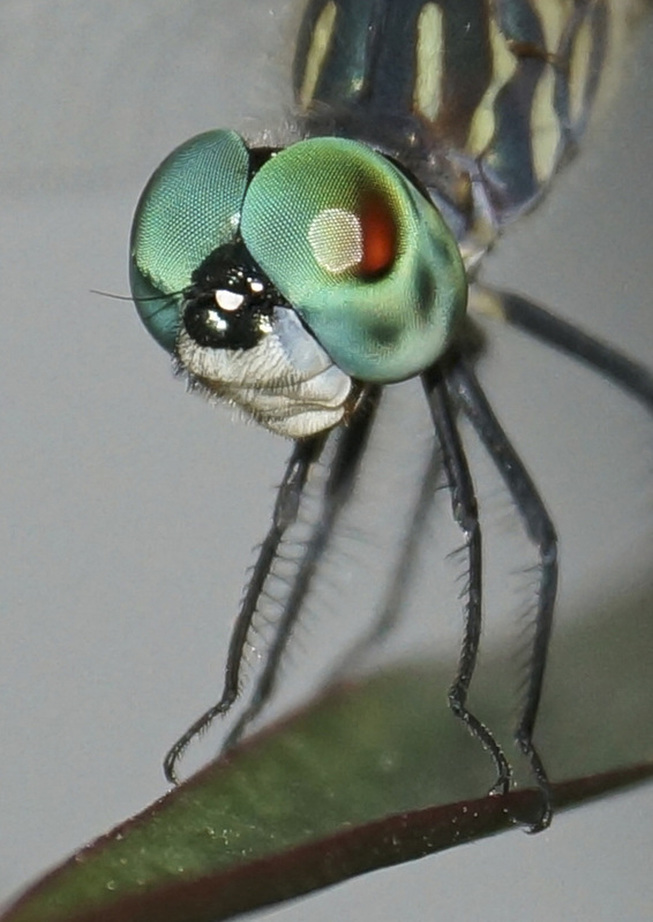Kind to Insects
Of course, bugs can't think or communicate with humans - or can they?
- story and photos by Ellis Anderson
Kerr pointed to the blinds inside the glass front door and said that they allowed her to observe the spider without it being aware of her presence.
Not that Spidey seemed concerned with the looming humans standing nearly face level with it. According to Kerr, if the spider felt threatened, it would make the web vibrate. To demonstrate, she moved her hand very, very close, waving it up and down to elicit a reaction. Spidey didn’t move. Nor did the web. “I guess she knows me now,” Kerr said, apologetically. At the same time she seemed pleased that Spidey trusted her. Many might call this a classic case of anthropomorphism, pasting human traits onto another creature. In this case, a spider that has a brain the size of a pin head. A small pin. How can a bug feel comfortable or learn to trust someone?
But recent studies show that both arachnids and insects can learn. Spiders can be trained to manipulate their webs to catch more food. And insects like honey bees can learn and remember colors and shapes.
Of course, one personal experience can be more persuasive than hundreds of facts compiled in a laboratory.
During Hurricane Georges (1998), some friends and I rode out the storm in the Creole cottage I used to own on Main Street. After the storm, we embarked on that time-honored coast tradition: driving around to see how your neighbors fared and clearing the roads in the process. With a chain saw loaded in the back of a big work truck, four of us headed out to check on the home of an elderly evacuee. When we arrived in the driveway, the guys got out and started cutting up a tree that had fallen across the house’s entrance. I was picking up branches and dragging them out of the drive when I spotted the largest dragonfly I’d ever seen. It was caught behind the front bumper of my friend’s truck. I never knew how it got there. Perhaps it had taken refuge in the storm or we had struck it while driving. It seemed vigorous enough, struggling to get through a narrow gap between two strips of chrome. But the sharp channel in which it was now lodged threatened to rip the delicate wings as it fought. Running my hand along the chrome, I realized that the bumper channel opened up once it turned the corner toward the side. But that was two feet away. I’d have to push the dragonfly along the groove and around the corner. If it fought me, it would never fly again. Hurricanes deplete the reserves of even the strongest people, and eventually, sleep deprivation stretches the boundaries of reality. So it didn't seem that strange to talk to a dragonfly that afternoon. I can’t remember exactly what I said - probably that I meant no harm, that I wanted to help, that it needed to trust me to survive. The dragonfly quieted as I spoke. He was probably as exhausted as I was. I reached out and touched him. He didn’t stir. I nudged him gently to the left. He still didn’t resist. I pushed again. And again. In tiny increments, we made it all the way to the bumper’s turn. As soon as he had a bit of maneuvering room, he flung himself into the air, startling me. Then I laughed as I watched him soaring in circles, higher and higher. The creature’s joy seemed palpable in the way it moved. I was surprised when it flew back down toward me. Before I realized what had happened, it landed on my left arm, up near my shoulder. It rested there for maybe thirty seconds. Surely not a minute. His blue goggle eyes and my brown ones met and held. Then he flew up and away a second time and did not reappear. I understand that it probably landed on me because it was confused or in shock. Dragonflies don't say thank-you. But I’ve always held on to the remote possibility that we two survivors, connected on some profound level that day in an attitude of mutual appreciation of our lives and reverence for our world.
Since my dragonfly experience, most insects have gotten a pass when they enter our home (although I remain an ardent murderer of the fearsome palmetto bugs and an expert slapper/dasher of mosquitoes). I have a catching system that relies on a transparent go-cup and a file folder. The cup goes over the bug, the folder slides beneath and out the door the intruder goes, whether wasp, moth, lady-bug or honey bee.
I taught this technique to my niece Anna when she was eleven. Years later, a school assignment asked her to sum up the character of people she knew, using only three words. Her description of me still makes us both laugh, but it's one of the best compliments I’ve ever had in my life: Kind To Insects. Kerr is a kindred Kind-to-Arachnids spirit. Last week, she let me take photos of Spidey and of her holding a sign directing visitors to the back door. This afternoon, she texted me. “Spidey not home this morning,” Kerr wrote. “Will give her a day then move her egg sacks to the back yard. Anticipating meeting some of her spiderling offspring in 2017!” I could tell by the next exchange that Kerr was already missing her friend. “She taught me a lot during her residency,” she wrote. “Not opening the door till morning. Just in case.” Comments are closed.
|
Categories
All
Archives
July 2024
|
Shoofly Magazine Partners
Our Shoofly Partners are local businesses and organizations who share our mission to enrich community life in Bay St. Louis, Waveland, Diamondhead and Pass Christian. These are limited in number to maximize visibility. Email us now to become a Shoofly Partner!

































 RSS Feed
RSS Feed























